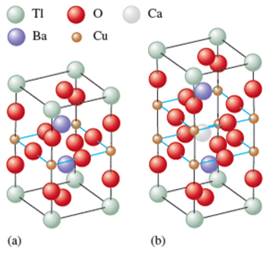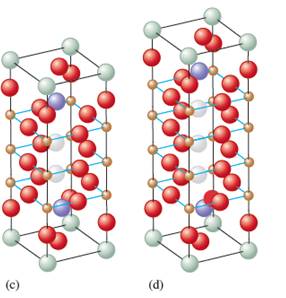
(a)
Interpretation: The formula of the four superconductors needs to be determined.
Concept Introduction: The superconductor is a substance which is capable of superconducting at very low temperature values.
(a)
Explanation of Solution
The given structures are as follows:


By considering the color code for spheres, the number of atoms of each element can be counted.
It can be observed that in molecule (a) there is 1 Tl, 2 Ba, 1 Cu and 5 O atoms in 1unit. Thus, the formula of the molecule will be:
Similarly, the atoms in molecule (b) are 1 Tl, 2 Ba, 1 Ca, 1 Cu and 7 O in 1unit. Thus, the formula will be:
The structure (c) contains 1 Tl, 2 Ba, 2 Ca, 3 Cu and 9 O atoms in 1unit. The formula will be:
Similarly, the structure (d) has 1 Tl, 2 Ba, 2 Ca, 4 Cu and 11 O atoms in 1unit thus, the molecular formula will be:
(b)
Interpretation: The four structures needs to be ordered from lowest to highest superconducting temperature.
Concept introduction: The number of sheets in the unit cell is directly proportional to the temperature for the superconductivity.
(b)
Explanation of Solution
If the number of sheets in each unit cell increases, the temperature for the superconductivity increases. The number of sheets in the structure (a) is less then (b) which is further less than (c) and (d). Thus, the increasing order of the superconductivity for 4 structures will be as follows:
(c)
Interpretation: The oxidation state needs to be assigned to Cu in each mixture. It is assumed that the oxidation state of Tl is +3. Also, the oxidation state of Ca, Ba, O is +2, +2 and -2 respectively.
Concept Introduction: The oxidation state of any atom in the molecule is equal to the charge on it. It can be calculated if oxidation state of all the other atoms is given.
For example, the molecule H2O2 is neutral. The oxidation state of H is +1 (general) thus, the oxidation state of O can be calculated as follows:
Thus, the oxidation state of O in H2O2 is -1.
(c)
Explanation of Solution
The oxidation state of Cu in structure can be calculated by taking the overall charge on the molecule equal to zero.
The oxidation state of Tl, Ca, Ba and O is assumed +3, +2, +2 and -2 respectively.
For
Thus, the oxidation state of Cu in molecule (a) is +3.
For
There are 2 Cu atoms, thus, there is a mixed oxidation state one is
For
Thus, copper has mixed oxidation state that is 1
For
There will be one
(d)
Interpretation: The reason for the copper to display a mixture of oxidation states in the superconductor needs to be explained.
Concept Introduction: The superconductor is a substance which is capable of superconducting at very low temperature values.
(d)
Explanation of Solution
There are variable oxidation states of copper due to varying the numbers of Ca, Cu and O atoms in each unit cell. The different oxidation states of Cu are calculated for molecules (b), (c) and (d). In the other superconductor in exercise 79, in YBa2Cu3O7, there is variable oxidation state of copper by omitting oxygen atom at various sites in the lattice.
Want to see more full solutions like this?
Chapter 16 Solutions
EBK CHEMICAL PRINCIPLES
- 19) Which metal is most commonly used in galvanization to protect steel structures from oxidation? Lead a. b. Tin C. Nickel d. Zinc 20) The following molecule is an example of a: R₁ R2- -N-R3 a. Secondary amine b. Secondary amide c. Tertiary amine d. Tertiary amidearrow_forwardpls helparrow_forwardIndicate the product of the reaction OH OH CH3-CC- Ph + H2SO4 a 20°C | CH3 Pharrow_forward
- 35) Complete the following equation by drawing the line the structure of the products that are formed. Please note that in some cases more than one product is possible. You must draw all possible products to recive full marks! a. ethanol + 2-propanol + H2SO4 → b. OH conc. H2SO4 CH2 H3C CH + K2Cr2O7 C. d. H3C A pressure CH3 + H2 CH Pt catalystarrow_forward21) The rate of reaction depends upon: a. the concentration and nature of reactants b. the temperature of the reaction C. whether or not a catalyst was used d. all of the above 22) A Maxwell-Boltzmann curve shows the distribution of molecular energies in a reaction system. When the temperature in this system is increased, the peak is a. higher and further to the right. b. higher and further to the left. c. lower and further to the right. d. lower and further to the left. 23) Which of the following correctly describes the reaction represented by the reaction below? CaCO3 (s) + energy → CaO (s) + CO2 (g) a. It is exothermic and the potential energy is greater in the reactants than the products. b. c. It is exothermic and the potential energy is greater in the products than the reactants. It is endothermic and the potential energy is greater in the products than the reactants. d. It is endothermic and the potential energy is equal for the products and reactants.arrow_forwardpls helparrow_forward
- 27) Draw the energy level diagram and write the full and shorthand electron configuration for a neutral sulfur atom.arrow_forwardIndicate whether these compounds are isomers, enantiomers, or tautomers. OCH OCH محمد ممدarrow_forward30) Substance A to E below are listed with several of their properties. The identities of the substances are identified in random order below: Iron, ethane, ethanol, sodium nitrate, graphite First classify each substance as either a polar covalent compound, non-polar covalent compound, ionic compound, metallic solid, or network solid. Write your predictions in the sixth coloumn of the chart, under "type of substance." Then, identify the identity of the substance in the last coloumn. Substance Melting Point Boiling Point Solubility in H₂O Electrical Conductivity Type of Substance Identity of Substance (°C) (°C) as: Solid, Liquids, Solution A -182 -88 Insoluble No/No/- B 1538 2862 Insoluble Yes/Yes/- C 308 380 Soluble Yes/Yes/Yes Ꭰ 3456 Insoluble No/-/- E -114 78 Soluble No/No/Noarrow_forward
 Physical ChemistryChemistryISBN:9781133958437Author:Ball, David W. (david Warren), BAER, TomasPublisher:Wadsworth Cengage Learning,
Physical ChemistryChemistryISBN:9781133958437Author:Ball, David W. (david Warren), BAER, TomasPublisher:Wadsworth Cengage Learning, Chemistry by OpenStax (2015-05-04)ChemistryISBN:9781938168390Author:Klaus Theopold, Richard H Langley, Paul Flowers, William R. Robinson, Mark BlaserPublisher:OpenStax
Chemistry by OpenStax (2015-05-04)ChemistryISBN:9781938168390Author:Klaus Theopold, Richard H Langley, Paul Flowers, William R. Robinson, Mark BlaserPublisher:OpenStax ChemistryChemistryISBN:9781305957404Author:Steven S. Zumdahl, Susan A. Zumdahl, Donald J. DeCostePublisher:Cengage Learning
ChemistryChemistryISBN:9781305957404Author:Steven S. Zumdahl, Susan A. Zumdahl, Donald J. DeCostePublisher:Cengage Learning Chemistry: An Atoms First ApproachChemistryISBN:9781305079243Author:Steven S. Zumdahl, Susan A. ZumdahlPublisher:Cengage Learning
Chemistry: An Atoms First ApproachChemistryISBN:9781305079243Author:Steven S. Zumdahl, Susan A. ZumdahlPublisher:Cengage Learning
 Chemistry: The Molecular ScienceChemistryISBN:9781285199047Author:John W. Moore, Conrad L. StanitskiPublisher:Cengage Learning
Chemistry: The Molecular ScienceChemistryISBN:9781285199047Author:John W. Moore, Conrad L. StanitskiPublisher:Cengage Learning





